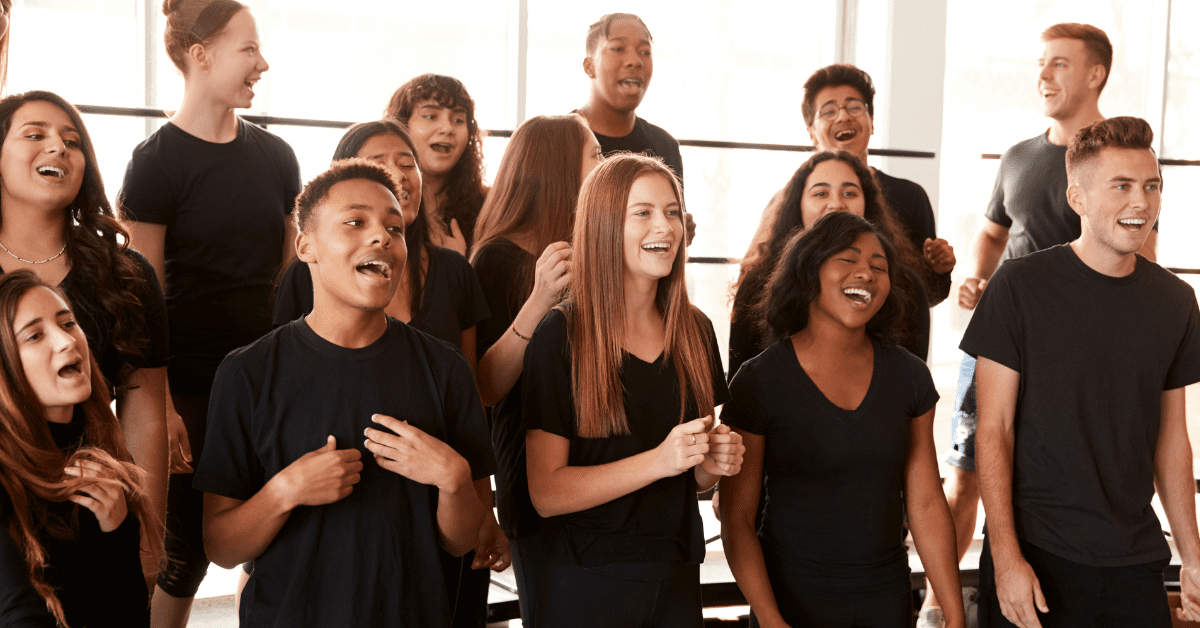“Sing to Our God a new song!” (Psalm 149 and others)
“But how could we sing a song to our God in a foreign land?” (Psalm 137)
“How long must I wrestle with my anguish,
and wallow in my despair all day long? (Psalm 13)
Why sing?
Human beings are made to make sound and presumably to sing. Assuming there is no damage to the larynx, lungs, and various sphincters involved, all bodies can produce sustained vocal sounds which is the basis of singing. Sometimes trauma, physical or emotional, will silence the song of an individual. That is when the song of the community—songs of praise or lament, joy or anguish, are songs we can sing to sustain one another, to lift up and build up the body of Christ; to weep with those who weep and rejoice with those who rejoice.
Music also has the ability to more deeply encode memories, imbued with emotion. It will be the songs we learn in our youth by memory that we will still be able to access even through the thickest parts of dementia. In multiple studies, groups who sing together are found to produce benefits for the individuals in the form of lowered blood pressures, better lung capacities, better memory, and better processing of emotions (among other benefits).
The choir (or as I like to call them, the “rehearsed expression of the congregation’s song”) can benefit the congregation as a group of highly engaged persons whose spiritual development is tied intrinsically to the act of worship, the study of scripture, and the proclamation of God’s promises through music. They can help encourage and teach new songs to the congregation. They can serve as worship leaders and set the tone for the service by their demeanor and actions. They can help the congregation proclaim God’s promises through hymns, songs and liturgical settings which in turn spiritually forms the individuals in the assembly.
Making music during worship is a spiritual practice that can be done alone, during our own devotional time and during corporate worship. What has been difficult in the last two years is trying to sing together during worship, while apart. And in many contexts, congregational song is failing. At risk in this failure is the health not only of the congregation itself but also of the individuals who make up that congregation. It is their physical, emotional, and spiritual health that suffers without singing together.
Like so many things in our life, these last two years of pandemic have shown ways in which parts of our life together were not as strong or healthy as we wanted to believe. So many organizations have found that what they took to be slightly shaken engagement was really a house built on sand, ready to crumble. Congregations have been thrust into remote working far quicker than they were ready for and congregations have come face to face with the hard question of what does it mean to be the church? What is membership and what is worship?
COVID called the question, and we weren’t ready. And maybe we still aren’t. But we are still needing to press on as this massive shift births something new for the church in the world.
Broadcasts versus participatory events
As worship leaders we have mostly figured out how to broadcast readings and sermons to our congregations. The part that we’ve gotten stuck on is “how do we sing together?” Do you sing the hymns along with a livestream at home?
The trend of not singing is not new but rather one that started several decades ago and has only been revealed more clearly by the pandemic. Some of this reluctance is because of the way our culture has professionalized music making. Only those who are “good” should sing, play, or make music. It is a competition and therefore, if I’m not great at it, I won’t do it.
Some of the professionalism has grown from children hearing that if they can’t match the pitches well, they should just “mouth the words”. Often this message is received by boys during puberty while their voices are changing, but girls heard this message as well. I’m not sure that phrase was ever spoken as often and widespread as is being reported, but I do believe that people heard that message and internalized it for all time. And passed it on to their children.
Listen the next time you celebrate a birthday—are people singing the birthday song or are they droning? Or singing wildly off-key on purpose? Do people even try to match pitch? What mood do these choices create?
As a worship planner, a preacher, and worship leader, are we addressing or reinforcing those messages about who “should” sing in worship?
Another issue that has been revealed is our culture’s tendency toward personal preference. As a church musician or a pastor I’m sure you can remember dozens if not hundreds of comments about the service based on whether someone “liked” or “didn’t like” the hymns, songs, or liturgy. These sentiments are expressed far more often than whether someone did or didn’t “like” the readings of the day. How are we talking about the music of the day? Do people know that the hymns and songs are chosen to illuminate the themes of the readings? (They are, right?)
How do we begin again?
How to care for the people’s song as we move back into more in-person singing is complicated and will be different for each congregation.
Were your people singing before? Do they need to be given permission or do they need encouragement and coaching?
The effect we have together
Alice Parker starts workshops with humming and matching pitch. As the group continues the tone a synergy and oneness is established. We are no longer individuals but rather participants in the creation of a SOUND. As we continue to hum it’s like when you repeat a word over and over again until you lose the meaning. Are we creating the tone or are we in the tone? I feel as if I can move in and out of vibration of the sound as I breathe.
In the congregation the rhythm of the music helps us to create the same effect. The words we sing are more in unison than the words we speak because of the rhythm of the music. The sound of the melody, the rising and falling pitches, help us to imbue the words with emotional content that a monotone recitation of text doesn’t allow. Really listen to your congregation’s recitation of the creed or the Lord’s Prayer or their spoken liturgy of the table. Is there any joy in the message of those words?
But in our singing the composer brings us out of our doldrums and not only are we creating a sound that paints the emotions of the text, but we are doing it together. This sound cloud is actually something we cannot create alone. We need each other.
What then should we sing? Advice for worship planners
In no other time in history has more music been available to congregations. Those who plan worship have the responsibility to help the congregation proclaim God’s promises along with our prayer, praise, and lament to God. Worship music planners are part of the spiritual formation team of the congregation, helping them to sing the whole story of God’s salvation and love throughout time and from the church of all time and space. With that goal in mind here are some ideas:
Start with your denominational hymnal. The committees who chose those songs did so with worship and your lectionary and church seasons in mind. Add songs and spiritual songs from other contexts judiciously. Take a close look at the text. Does it align with your theology or is it just catchy and popular?
- Preparation. If you don’t have a record of what the congregation has sung for the last 5-7 years you’ll need to research. If you have printed bulletins, get a team together to review them and make a list of all the songs (and the hymn numbers) of what has been sung. If you have a hymn/song book I find the best way is to write the date the song was included in worship on the page of the hymn/song. This gives you an easy visual assessment of whether and how often this particular hymn was included.
- What do we know? As you plan worship, keep in mind that learning new music is hard for most in the congregation. Most are worn down by services that require them to sing mostly new songs. So strive for a balance of mostly known.
- What should we know? Most denominational hymn books now include a wide variety of hymns and songs from around the world and cultures within the U.S. What is the importance of singing with the whole church around the world—not as performative appropriation, but in solidarity? Are there other hymns/songs that this congregation doesn’t know that would be helpful in their spiritual formation or are there hymns/songs that illuminate a theme that is relevant to the context this year for these readings?
How can we teach a new song?
Every song was once new. If we only sing the ones we know and love we are denying the Holy Spirit’s continued inspiration of poets and musicians today. That said, a new hymn, song, or even new liturgy, should be carefully introduced. Preachers and musicians should partner together in love.
Easiest learned songs for groups are based on folk-tunes and are composed with steps and skips that can be predicted and thus easily learned. Pop and art songs are a little harder for groups and better learned by repetition. The tune can be included in a prelude or meditative setting a few weeks before the hymn is sung; a soloist or small group can introduce the song. My rule of thumb is that a group needs to sing a song at least six times to learn it, so try to hold your evaluation of a particular hymn/song open for some time before deciding whether it should be included in the regular canon of the congregation.




